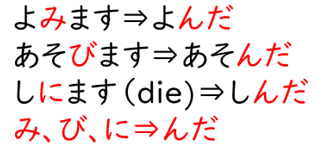Hello and welcome to Nihongoいちにのさん!!
Let's study Japanese grammar together.
Verb た(ta)form <動詞た形(どうし たけい)>
The conjugational forms of verbs that end in "た" or "だ" are called "た形(たけい)(た-form)".
Here we will explain how to make "た形(た form)" from "ます形(ます form)".
The method varies depending on the verb group.
Here we will explain how to make "た形(た form)" from "ます形(ます form)".
The method varies depending on the verb group.
・💁The Explanation about Verb groups ↓↓
※If you remember verb てform(動詞て形), there is an easier way to make verb たform.
Please look at the last part of this page.
<Ⅱ, Ⅲグループ>
For Ⅱ,Ⅲ group of verbs, simply change the "ます"to "た".
(Add "た" to the stem, which is the part before ます in the ます form.)
(Add "た" to the stem, which is the part before ます in the ます form.)
<Ⅰグループ>
Verbs in groupⅠ are conjugated differently depending on the character before "ます".
(The conjugation changes depending on the last part of the stem)
①When the last character (sound) of the word stem,that is, the charactere immediately before "ます" is the character for "い", "ち", or "り", that part will be changed to "った".
(The conjugation changes depending on the last part of the stem)
①When the last character (sound) of the word stem,that is, the charactere immediately before "ます" is the character for "い", "ち", or "り", that part will be changed to "った".
②When the last character (sound) of the word stem,that is, the charactere immediately before "ます" is the character for "み", "び", or "に", that part will be changed to "んだ".
③When the last character (sound) of the word stem,that is, the charactere immediately before "ます" is the character for "き", that part will be changed to "いた".
※Note, if the verb is "行きます(いきます, go)," it is specially changed to "行った”.
④When the last character (sound) of the word stem,that is, the charactere immediately before "ます" is the character for "ぎ", that part will be changed to "いだ".
⑤When the last character (sound) of the word stem,that is, the charactere immediately before "ます" is the character for "し", that part will be changed to "した".
※If you remember verb てform(動詞て形), simply replace て to た, or で to だ .
・💁The Explanation about Verb てform ↓↓










